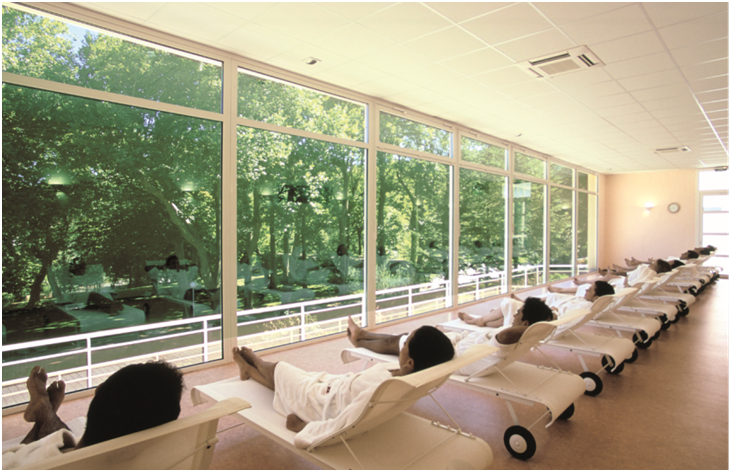
When in doubt, ask a horse. That’s what villagers did nearly 300 years ago in the Languedoc’s Orb Valley in the South of France, a relatively unchanged high plateau region wedged between the River Rhone and the Pyrenees. There, amid a bottle-green landscape of pine and chestnut trees and rocky outcroppings, a poor, diseased horse was put to pasture. As the legend goes, he led himself to water—and after days of bathing and drinking from a relatively unknown spring, his lesions disappeared and his health returned. Villagers with skin and sight disorders followed suite and soon a spa was born.
I arrive to Avene les Bains less afflicted than the horse. Still, I suffer from a mild case of eczema and have heard that water from the spring—called St. Odile in honor of the French patroness to the blind—can work dermatological wonders. Officially acknowledged by health experts and the French government since 1874, the curative water emerges in Avene after a 40 year, filtering journey in the subsoil of the Cevennes Mountains. Loaded with silica, the thermal water has a low mineral content and a neutral ph factor which makes it ideal for soothing burns and the irritations of eczema and psoriasis. But these days, nobody dives right into the spring. Rather, they take their baths under medical supervision in the chic Avene Hydrotherapy Centre, renowned globally for its reversing results.
My favorite medicine is the bath I enjoy each day in the velvety, tepid water . . . though I swoon to the prickles of the swirling water attack, it’s the miraculous outdoor landscape that most restores me.
Not far from Montpellier, the village of Avene rises like a funnel cloud along the mountain. Spiraling uphill in characteristic medieval fashion, it’s all ancient footpaths, brooding buildings, canted headstones, red-roofed houses—and a church that tops the antique hamlet like an ornamental crown. Timeless, the tiny village smacks of Bruegel. Men laden with egg baskets pass others bearing great bouquets of flowers. Stout ladies totter downhill at surprising speed—as agile as ballet dancers. They dodge feisty children who tease lazy dogs into games of chase, then wish gruff gun-bearing huntsmen good luck in their morning pursuit of wild boar. As I gaze in wonderment, a woman my age gestures to her house, proud that her family has inhabited it for over 300 years.
And yet, just across a grizzled bridge, sits the contrasting modernity of the contemporary spa complex. From April to October, the hydrotherapy center fills with patients with epidermal disorders. While they hail from around the globe, many come from France, where doctors order their treatments and send them for a three week cure—most of which is covered by insurance. Some return annually, attracted by proven results and alternatives to conventional treatments, such as steroid creams. Others, find their condition can be eradicated in just one, relaxing stay. Many check into the center’s Val D’Orb Hotel (a touted “green” hotel) , feast at its gourmet restaurant (can foie gras really be part of the cure?) and enjoy its three star amenities. Still, others rent a gite, bring their families (30 percent of the patients are children),and turn their treatment into a holiday.
While prescriptions are necessary for treatment at the Hydrotherapy Centre, doctors on site can provide them. Most visitors come for at least three weeks, but some, like me, have less time. Still, it’s all about wallowing in the water from the St. Odile Spring, a source that gushes 70,000 litres per hour of pure, healing goodness. I spend my handful of days in the spa bathing, showering, taking wraps, and lounging about on a sundeck—per doctor’s orders. I adore a localized treatment where a machine kneads my scalp with water jets. As urged, I drink a full litre of the clear, tasteless water daily. Yet, my favorite medicine is the bath I enjoy each day in the velvety, tepid water. The huge tub, armed with hydro massage jets, faces a curtainless window, and though I swoon to the prickles of the swirling water attack, it’s the miraculous outdoor landscape that most restores me.
I stop itching after a few days, which is more than I can say for Napoleon who was scheduled to stay at the spa in 1811, but had to cancel due to military obligations. One wonders how the world might differ today had the General been able to alleviate his acute “itching of the thighs.” At any rate, if he lived today, he’d be able to buy Avene’s water and spray it on his burns, wounds, and skin disorders himself. The skincare products, first created for patients to take home to elongate the benefits of their stay, are now sold in pharmacies and prescribed by doctors worldwide. They can be used by anyone wishing to eradicate skin issues. Still, a spritzer bottle of eau St. Odile is no substitute for a week or two taking baths in a little village in the South of France. As one doctor tells me, “Part of the magic here is the scenery.” avenehydrotherapycenter
Becca Hensley
Becca Hensley is Editor at Large for Insider's Guide to Spas. Based in Austin, she writes regularly about travel and spas. She believes a good story draws you in like laughter in a crowded room, and challenges you to do it justice. Her work appears regularly in Austin Monthly, Travel Channel, Toronto Star and National Geographic Traveler.